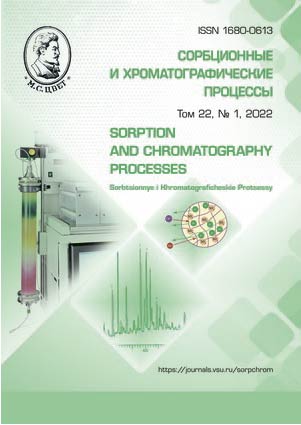Chromatographic determination of zeaxanthin in some varieties of Сapsicum annum
Abstract
We studied the carotenoid composition of nine varieties of orange bell pepper (Capsicum annuum). It was found that the orange colouring could be caused both by an accumulation of zeaxanthin (unesterified, monoesters, and diesters) and by a mixture of yellow (when biosynthesis continues to epoxidation products) and red (when the latter are not fully transformed into capsanthin and capsorubin derivatives) xanthophylls. It was shown that it was possible to differentiate substances in this case by the analysis of electronic absorption spectra of acetone extracts of the fruit. However, the spectrophotometric method does not allow the differentiation between β-carotene, β-cryptoxanthin, and its esters, as well as between zeaxanthin and its esters.
Only zeaxanthin (and its esters) is effective in the prevention and treatment of age-related macular degeneration (AMD). Therefore, it is particularly important to find sources of zeaxanthin, which are quite rare in the Russian flora. In this regard, it is possible to use thin layer chromatography on silica gel or an even more informative method, reversed-phase HPLC, in the next step of biosynthesis end-stage control. In thin layer chromatography (TLC), the separation on silica gel plates is based on the difference in quantity and quality of the polar groups. It is almost independent of the lipophilicity associated with the higher fatty acid radicals forming the corresponding esters. It was noted that it is easy to achieve the conditions when β-carotene, as a component with no polar groups, has the highest chromatographic mobility, β-cryptoxanthin esters (with only one polar ester group) have a considerably lower mobility, and zeaxanthin diesters (with two polar ester groups) have an even longer retention time. Unesterified β-cryptoxanthin (has one OH-group), zeaxanthin monoesters (with one OH- and one ester group), and also unesterified zeaxanthin have low mobility, remaining at the start line or close to it (n-hexane-acetone mobile phase 20:0.3). Reversed phase HPLC also allows separation of all the above components, and they are easily separated from the epoxidation products of zeaxanthin. It is possible to determine the radical distribution of lauric, myristic, and palmitic acids over the mono- and diesters. It was found that among the four varieties of pepper containing zeaxanthin derivatives the level of their accumulation is in the range of 15-25 mg per 100 g of fresh fruit. This amount can provide the daily requirement for zeaxanthin (2 mg) if the food is prepared properly.
Downloads
References
Anaya-Esparza L.M., de la Mora Z.V., Vázquez-Paulino O. et al., Molecules, 2021, Vol. 26, pp. 5341. https://doi.org/10.3390/molecules26175341.
Lemos V.C., Reimer J.J., Wormit A., Ag-riculture, 2019, Vol. 9, pp. 81; https://doi.org/10.3390/agriculture9040081.
Lang Y.-Q., Yanagawa S., Sasanuma T. et al., Breeding Sci., 2004, Vol. 54, pp. 33-39. https://doi.org/10.1270/jsbbs.54.33.
Arimboor R., Natarajan R.B., Menon K.R. et al., J. Food Sci. Technol., 2015, Vol. 52, pp. 1258-1271. https://doi.org/10.1007/s13197-014-1260-7.
Hassan N.V., Yusof N.A., Yahaya A.E. et al., Antioxidants, 2019, Vol. 8, pp. 469. https://doi.org/10.3390/antiox8100469
Carpentier S., Knaus M., Suh M., Crit. Rev. Food Sci. Nutr., 2009, Vol. 49, pp. 313-326. https://doi.org/10.1080/10408390802066979.
Deineka V.I., Sorokopudov V.N., Dein-eka L.A. et al., Pharm. Chem. J., 2007, Vol. 41, pp. 540-542. https://doi.org/10.1007/s11094-008-0007-z.
Deineka V.I., Sorokopudov V.N., Dein-eka L.A. et al., Pharm. Chem. J., 2008, Vol. 42, pp. 87-88. https://doi.org/10.1007/s11094-008-0065-2.
Guzman I., Hamby S., Romero J. et al., Plant Sci., 2010, Vol. 179, pp. 49-59. https://doi.org/10.1016/j.plantsci.2010.04.014.
Wall M.M., Waddell C.A., Bosland P.W., Hort. Sci., 2001, Vol. 36, pp. 746-749. https://doi.org/10.21273/HORTSCI.36.4.746.
Sajilata M.G., Singhal R.S., Kama M.Y., Compr. Rev. Food Sci. Food Safety, 2008, Vol. 7, pp. 29-49. https://doi.org/10.1111/j.1541-4337.2007.00028.x
Zeb A., Murkovic M., J. Planar Chro-mat., 2000, Vol. 2, pp. 94-103. https://doi.org/10.1556/JPC.23.2010.2.1.
Bunea A., Socaciu C., Pintea A., Not. Bot. Horti. Agrobo, 2014, Vol. 42, pp. 310-324. https://doi.org/10.15835/nbha4229700.
Wu L., Huang X., Shi K., Tan R., Braz. J. Poultry Sci., 2009, Vol. 11, pp. 95-98. https://doi.org/10.1590/S1516-635X2009000200004
Zenkevich I.G., J. Chemometrics, 2009, Vol. 23, pp. 179-187. https://doi.org/10.1002/cem.1214







